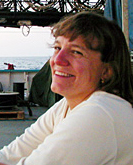Well, it finally happened. The unusually fine weather we had for nearly three weeks came to an end last night as a moderately strong low pressure system swept by us. The winds picked up, as did the seas, and the shampoo bottle — my highly sophisticated barometer -tumbled over as the Knorr pitched and rolled […]
Read More
Not the greatest day today. I had been hoping to deploy another of my sound source moorings, but at the last minute it didn’t work out. Since we added this side trip toward Greenland, I had an opportunity to re-position a sound source mooring that was actually scheduled to be set during the next OSNAP […]
Read More
Late last night, we finished our second transect along our part of the OSNAP line. At the cruise outset, we transited from west to east (from off the coast of Greenland to Scotland) laying down about 20 deep-sea moorings. Then we turned right around and re-traced our steps, this time using the CTD package to […]
Read More
I finally climbed into my bunk this morning at 5 AM, after 20 hours without sleep. There was a break in the RAFOS float deployments—a chance to get a little rest. I dozed off right away, inspite of being rather jazzed up by all the stress of choosing the right float release positions. But just […]
Read More
We’ve just started the busiest portion of this cruise for the RAFOS float program. Today we have released the first 2 of the 10 deep floats that will sink to near the sea floor and drift with the currents there for the next two years. It is very tricky to find the best positions for […]
Read More
On Saturday, we reached the eastern-most point of this expedition, just a few 10s of miles off the western coast of Scotland. We could almost hear the bagpipes ! Our Scottish colleagues, led by OSNAP principal investigator Stuart Cunningham, deployed the last of the moorings–a trawl-resistant frame with an acoustic Doppler current profiler, or ADCP, inside. […]
Read More
One Ocean Insight blog reader remarked recently that he found it so funny that there was an oceanographer that used Jaws! I had never made that connection myself, perhaps because what I study is not what most people think of as oceanography. What do you think of when someone says “oceanography”? According to my unscientific […]
Read More
We are slowly getting closer to the Scottish coast, the eastern end of our “line”. We have just 2 or 3 more moorings to deploy before we turn back west and re-trace our steps, or maybe more accurately, our wake. The air and water temperatures are warmer here – almost 60F! A heat wave! It […]
Read More
I took the weekend off from blogging, but that doesn’t mean that science stopped on Saturday or Sunday. Our work continues almost 24 hours a day, 7 days a week. Research vessels like the R/V Knorr are so expensive to operate that once we are at our work site, we need to keep moving along […]
Read More
For the past several days, we have been making our way over an underwater mountain chain called the Mid-Atlantic Ridge, or MAR for short. This ridge, which snakes its way southward from Iceland through the North and South Atlantic, results from the spreading of two tectonic plates and the bubbling up of molten rock to […]
Read More
About Amy Bower
 Amy Bower is a physical oceanographer at the Woods Hole Oceanographic Institution. She has been chasing ocean currents in the Atlantic and Indian Oceans for over 25 years, primarily by releasing acoustically tracked floats far below the sea surface. Legally blind since her mid-20s, Amy uses adaptive technology to continue her research.
Amy Bower is a physical oceanographer at the Woods Hole Oceanographic Institution. She has been chasing ocean currents in the Atlantic and Indian Oceans for over 25 years, primarily by releasing acoustically tracked floats far below the sea surface. Legally blind since her mid-20s, Amy uses adaptive technology to continue her research.
Related Links

